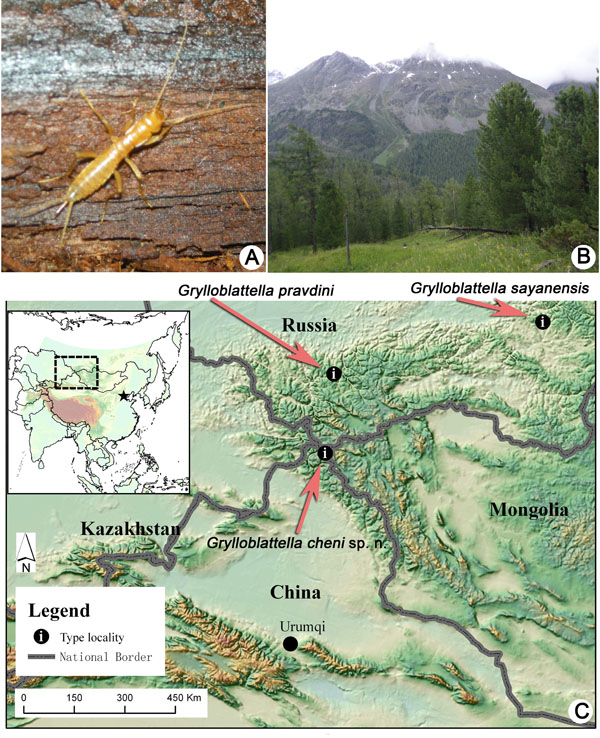Modern grylloblattids (ice crawlers) are restricted to cold and extreme habitats that are difficult to access. They are one of the least diverse of the modern insect orders. Ice crawlers can be considered as “living fossils” with presently relict distributions. Few entomologists have ever collected these unique insects, and little is known about their life history and biology.
Grylloblattids are extremely rare in China. Mr. Shu-Yong Wang collected the first grylloblattid from China, which was one male Galloisiana sinensis specimen from Mt. Changbaishan, Jilin in 1986. Over 23 years later, Mr. Ke-Qing Song, a PhD student, collected the second grylloblattid from China, which is one female Grylloblattella cheni sp. nov. in Akekule Lake (White Lake), Xinjiang, China.
A comparison of the thorax of extant and extinct Grylloblattodea is presented, with an emphasis on the pronotum using geometric morphometric analysis, which may reflect thorax adaptation and the evolution of Grylloblattodea. Highly diversified pronota of extinct Grylloblattodea may reflect diverse habitats and niches. The relatively homogeneous pronota of modern grylloblattids might be explained by two hypotheses: synapomorphy or convergent evolution. Most fossils of Grylloblattodea contain an obviously longer meso- and metathorax than prothorax. The length of the meso- and metathorax of modern grylloblattids is normally shorter than the prothorax. This may be associated with the wing loss, which is accompanied by muscle reduction and changes to the thoracic skeleton system. Threats to grylloblattids and several conservation comments are also provided. Potential global distribution of grylloblattids is inferred.
The results of this work were recently published in PLoS ONE. This research was partly supported by the grants from the Key Laboratory of Zoological Systematics and Evolution of the Chinese Academy of Sciences (No. O529YX5105), the National Science Fund for Fostering Talents in Basic Research (Special Subjects in Animal Taxonomy, NSFC-J0630964/J0109, J0930004). Discovery of the unique specimen resulted from North Xinjiang Environment Exploration Program presided by Dr. Run-Zhi Zhang, Professor of the Institute of Zoology, Chinese Academy of Sciences.
Ming Bai, Karl Jarvis, Shu-Yong Wang, Ke-Qing Song, Yan-Ping Wang, Zhi-Liang Wang, Wen-Zhu Li, Wei Wang and Xing-Ke Yang*. 2010. A second new species of ice crawlers from China (Insecta: Grylloblattodea), with thorax evolution and the prediction of potential distribution. PLoS ONE, 5(9):e12850.
Internet access: http://dx.plos.org/10.1371/journal.pone.0012850

(A) Female. (B) Habitat. (C) Type localities of all known three species of Grylloblattella.

